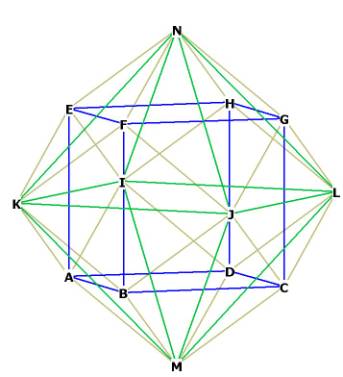|
(2019
midterm assignment) Model Midterm answers 2019 (Index) Essay 2: Start Research Report |
 |
D'Layne Lee
Symbolism in the Garden
Eden:
an unspoiled paradise… until the perfection was tainted by human nature. Eve was
the woman, helper, mother, and door to sin into Eden. While some read this
scriptural account for religious or historical reasons, it can also be viewed as
a literary piece that contains things relevant to literature – symbolism being
one. Symbols are part of the larger context of the meaning, they are not
independent but correlate with each other as a network. They often create
images, but words themselves are symbols that convey meaning. A symbol can be as
obvious as red on a stoplight, or have a discreet meaning one might not
initially catch. These hidden symbols, though we might not realize they are
there, still work on a reader because we never stop thinking about symbols on
the unconscious level. Genesis introduces some symbolism that is key to the
apocalypse in Revelation, they appear and reappear because they are foundational
to the meaning of the stories. The more obvious ones present in the scriptures
often carry over into modern literature because the meanings are familiar to
readers and convey a message more easily grasped. Some of these symbols are so
integrated into our everyday life that we don’t readily recognize this. From
genesis, to Revelation, to literature of today, creation and apocalypse
symbolism has been kept alive through readers.
Some symbols one might find in Genesis
range from natural things like rivers and plants, to as abstract things as
numbers. The amount of depth one could explore here is an enormous undertaking,
there is no easy way to break it up because the biblical symbolism is so
extremely embedded that the reader must look at all sixty-six books to gain a
complete understanding. The good thing, however, is that many have a basic
understanding because these symbols have also embedded themselves into our daily
lives—some terms and images have become as common as “red means stop”. Once your
eyes have been opened to the meaning behind a term or image, it is easier to
identify them in other contexts. So many concepts are conveyed through using
symbols. Authors write from what they know, their beliefs about the future often
come across in their writing and this ties back to scripture in many instances.
One of the major themes in scripture is “completeness
and achievement” by the holy Father. The way this presents itself is in the
number seven, which translates to that meaning. For example, the Bible itself
was originally divided into seven major divisions; these are the Law, the
Prophets, the Psalms, the Gospels and Acts, the General Epistles, the Epistles
of Paul, and finally Revelation (BibleStudy Tools, 2018). From beginning to end,
this exact symbol is prevalent in numerous ways. In the creation narrative,
seven is the number of days it took God to create the heavens and the earth
(chapter 2). Later in Revelation, the apocalypse narrative, seven appears over
and over again. From the seven churches to the Lamb with seven horns and seven
eyes, this number is a strong symbol.
The way this symbol is active in the lives of many
people today is the seventh day of rest/sabbath. Sundays (or sometimes
Saturdays) are often taken to recoup for the upcoming week and let the work rest
while one rests his body. This comes from Genesis when it states, “On the
seventh day, God rested” (chapter 2, verses 2-3). Even beyond this, the number
seven as a symbol appears in modern literature. For example,
Parable of the Sower utilizes the
power of this number by briefly mentioning it throughout (Butler, 1993). In the
story of a young girl growing up in an apocalyptic society, Butler conveyed the
tragedy of losing a three-year-old to a gunshot by giving a visual of the
“bullet proof” neighborhood gate – it had six bullet holes and a seventh dent.
Violence was rampant and weakening their neighborhood, and the gate was barely
holding together. They were losing the perfection of creation.
Another prevalent symbol in scripture are the trees that
make up the garden. Genesis is centered in a garden with two particularly
important trees – the tree of life, and the tree of knowledge of good and evil.
The God given directions were that man could eat of any tree except the tree of
knowledge. When man disobeyed this command, sin entered the garden which made it
unfit for mankind to reside in. The power behind the trees is that they
represented the free will God gave to man. We could eat of His eternal life and
be whole for eternity, or eat of worldly knowledge and be brought into sin for
eternity. Thankfully, there is a redemption story in Revelation where the trees
reappear. Those who, in their hearts, live for the Lord get to eat and drink of
him (chapter 22). The river of living water and the tree of life symbolize
living forever with Christ in a holy society.
In the lives of believers, those that read the
scriptures for religious reasons, these trees are more common, but it is not
usually a nonbeliever that will speak about the tree of life. However, the
symbolism of trees in a garden meaning life or death is present in literature
even if the reader doesn’t quite catch it. For example, in the same text
mentioned above, Butler placed the setting in a garden. As God began humanity,
so did this community – fruits and vegetables were their sustenance. When evil
entered their protected community, like sin entered Eden, the entire thing was
abandoned because it was no longer fit to be their home. In the ending of
Parable the survivors make a plan to
begin a new garden, their own version of a safe and “holy” society.
These are only two of the many examples of symbolism in
the garden that carry over to Revelation as well as modern literature. The
number seven and the garden sanctuary are prevalent in many areas of literature,
but can ultimately be tied to their origin in scripture. Symbols create networks
that tie ideas and images to meanings, which is why narratives can have such
deep concepts conveyed in seemingly simple language.
The Holy Bible
BUTLER, O.
E. (2019). PARABLE OF
THE SOWER.
Place of publication not identified: GRAND CENTRAL PUB.
The Number 7 in the Bible - Enlightening Scripture Quotes and Meaning. (n.d.). Retrieved March 27, 2019, from https://www.biblestudytools.com/topical-verses/the-number-7-in-the-bible/
 |
 |
 |
